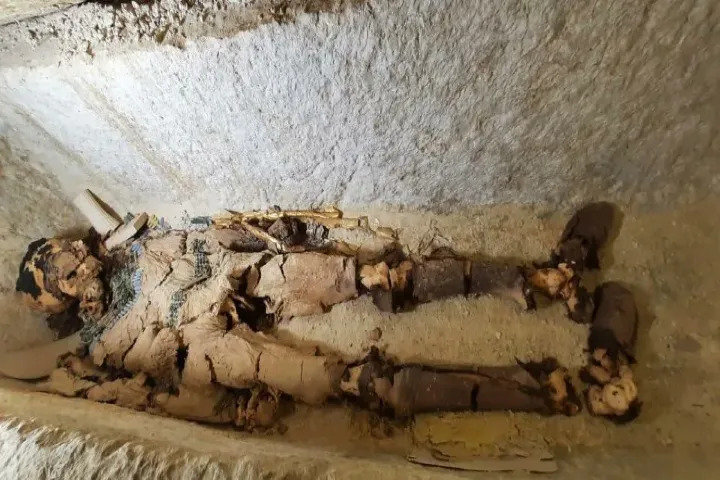

Led by Egypt's former Minister of Antiquities Zahi Hawass, a team of archaeologists found 4,300-year-old mummy (Pic. Courtesy Twitter/@AncientEgyptArt)
There was jubilation among the scholars and students of ancient Egyptian history as a team of archaeologists discovered what could possibly be the “most complete” and “oldest” mummy found so far.
A report in sciencealert.com said the remains are thought to be that of a man called Hekashepes and that it was a 4,300-year-old mummy.
The mummy belongs to the fifth and sixth dynasty which reigned from 2500 BCE to 2100 BCE, as per Zahi Hawass, Egypt’s former Minister of Antiquities and it was found in a tomb near Cairo.
Talking about the find Hawass commented: “It is the oldest mummy, complete and covered in gold, ever found in Egypt.” He went on to add that it was “the most amazing discovery”.
The discovery was made by Hawass-led team of 10 assistants, 20 metres or 66 feet underground at the Gisr el-Mudir enclosure. This place is near the ancient Step Pyramid of Djoser at the Necropolis of Saqqara, a UNESCO World Heritage Site.
Saqqara which is “great masterpiece of architectural design” is situated in Memphis, ancient Egypt’s first capital.
The mummy was found in a 25-tonne stone coffin in one of the shafts. The coffin’s lid itself weighed five tonnes. “I put my head inside to see what was inside the sarcophagus: A beautiful mummy of a man completely covered in layers of gold,” said Hawass. The mummy had a band on the head and bracelet on the chest, and this indicates that this was a rich man, he added.
Apart from this mummy many other “important archaeological discoveries” were made. Among them were tombs which belongs to Khnum-djed-ef, a priest in the Unas’ pyramid complex and Meri, a “keeper of the secrets” at the royal palace. The former dates back to the reign of King Unas during the fifth dynasty – from 2494 BC to 2487 BC.
This cemetery was for very important people, those who were “second after the King”, said Hawass.
In the shaft three statues which represent one person were found while behind a false door nine other statues were discovered. These are considered important as they provide information and knowledge for the first time about Old Kingdom’s art. The varied statues included single, double and servant statues.
The archaeologists also unearthed a large number of tools of daily use, stone vessels and amulets.
Stressing on the significance of the find, Ali Abu Deshish, another archaeologist from the team said: “This discovery is so important as it connects the kings with the people living around them.”
In a groundbreaking study, researchers from McGill University have identified nine biological markers in the…
India, in a firm and unequivocal statement at the United Nations Security Council (UNSC), accused…
External Affairs Minister S Jaishankar shared his remarks on how India and Germany can upgrade…
Germany has come out resolutely behind India and its fight against terrorism under Operation Sindoor.…
Baloch leader Mehran Marri has accused Pakistan of unlawfully occupying Balochistan since 1948, transforming the…
The Trump administration announced on Wednesday that it will continue its efforts to prevent advanced…